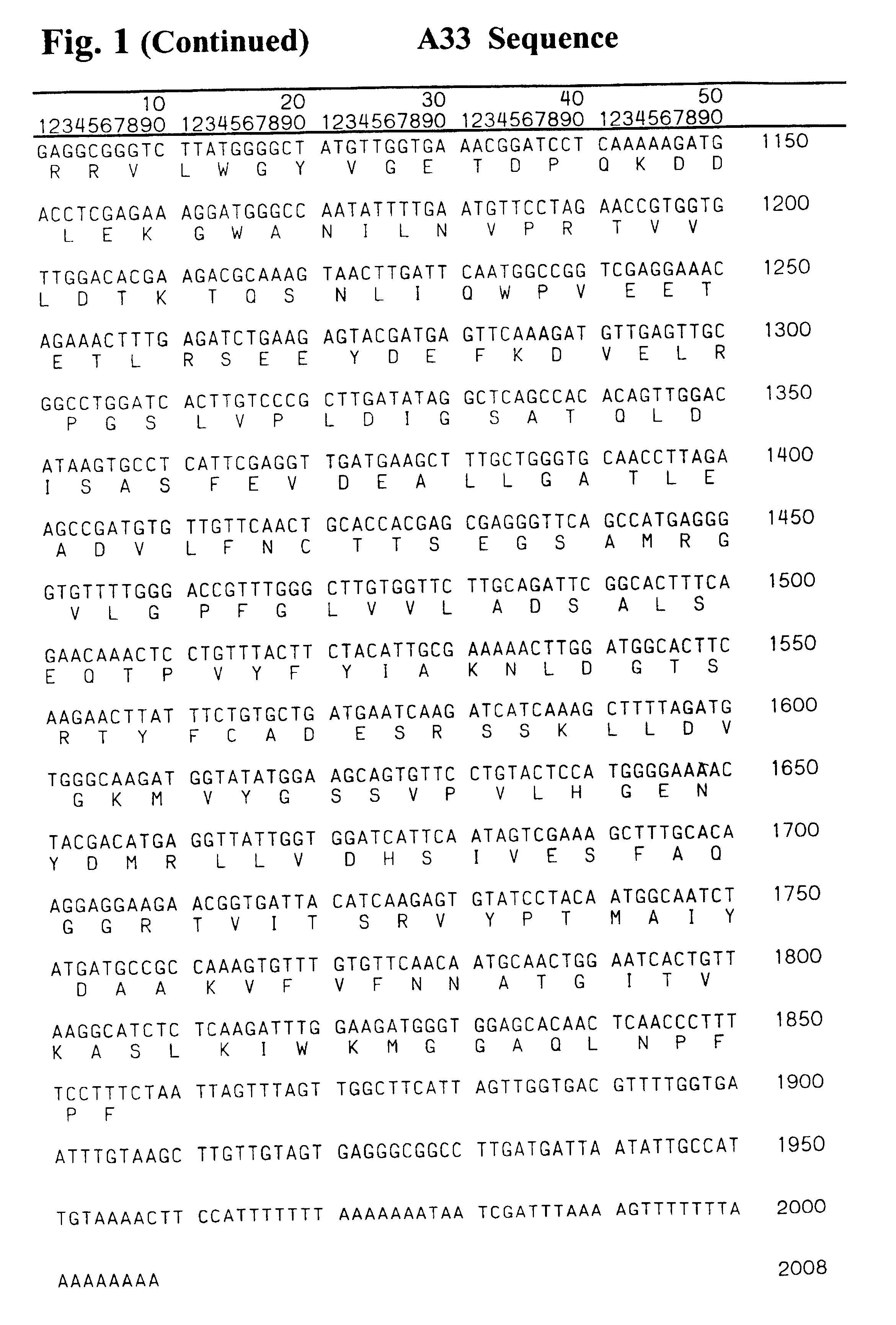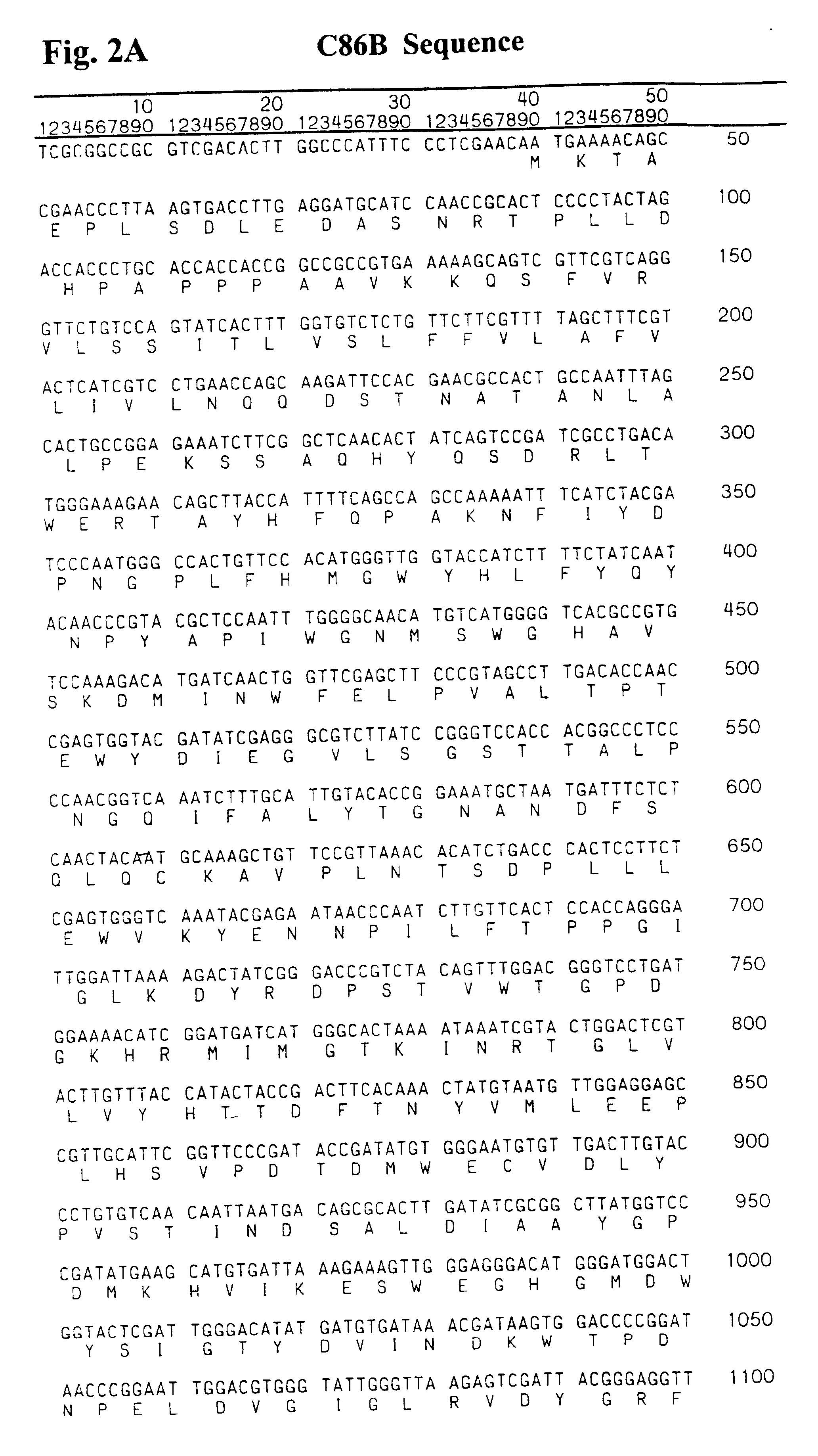Transgenic plants presenting a modified inulin producing profile
a technology of inulin and producing profile, which is applied in the direction of angiosperm/flowering plant, sugar derivative, enzyme, etc., can solve the problems of no experimental data on the oligosaccharides obtained, difficult derivatisation of said inulin, technical and economical disadvantages, etc., to improve the functional properties of inulin, improve the functional properties, and significant technical and economic advantages
- Summary
- Abstract
- Description
- Claims
- Application Information
AI Technical Summary
Benefits of technology
Problems solved by technology
Method used
Image
Examples
example 1
Isolation of a New cDNA from the cDNA Library of Helianthus tuberosus Homologous to sst103 and fft111 from Helianthus tuberosus
An Uni-ZAP cDNA library, constructed from mRNA isolated from H. tuberosus tubers, was screened with a mixture of a 840 bp sst103 and a 860 bp fft111 fragment. The sst103 specific fragment was obtained by PCR using primers 5'-TGTCAGCCCATCCCTTGGAAAGG-3' and 5'-TACGCTGTCAACTCGTCGG-3' and pSST103 (Van der Meer et al., 1998) as template. The fft111 specific fragment was obtained by PCR using 5'-GTTCAACGCTGCTTGATCCACC-3' and 5'-ACCACGGTCCTTCCAAACGG-3' and pFFT111 (Van der Meer et al, 1998) as template. Screening of about 100.000 cDNA clones yielded about 1200 positive clones, most of them most probably representing either a sst103 or a fft111 cDNA. Only the lambda ZAP clones giving a weak positive signal (84) were picked from the primary screening. After 34 rounds of purification, 11 clones were left. From these clones, the pBluescript phagemids were excised from ...
example 2
Isolation of a New cDNA from the cDNA Library of Cichorium intybusHomologous to sst103 and fft111 from Helianthus tuberosus
A Lambda TriplEx cDNA library, constructed from mRNA isolated from the tap roots of C. intybus, was screened with a mixture of a 840 bp sst103 and a 860 bp fft111 fragment (see example 1). The primary screening of about 60.000 cDNA clones yielded about 700 positive clones, of which 96 clones were picked. After 3-4 rounds of purification 81 clones were left. From 55 clones, the pTriplEx phagemids were excised from lambda Trip1Ex vector and the cloned insert characterised by restriction enzyme analysis and sequencing. The DNA sequence of one of the clones, designated c86b (Sequence ID. No. 3) and the corresponding amino acid sequence (Sequence ID. No. 4) is presented in FIG. 2A. Sequence ID. No. 3, designated c86b, has an open reading frame of 1851 base pairs and encodes a protein of 617 amino acid residues (Sequence ID. No. 4). On DNA level, c86b shows a 61% iden...
example 3
Analysis of Genomic Organisation and Expression of a33 in Helianthus tuberosus
To estimate the number of a33 genes present in the Jerusalem artichoke genome, Southern blot analysis of digested H. tuberosus DNA was performed, using a radio labelled a33 fragment of 1140 bp as a probe. (Plant Journal 15, 489-500). Under stringent conditions (hybridisation at 65.degree. C. and washing at 65.degree. C., 0.1.times.SSC, 0.1% SDS), only one, maybe two fragments of the AflII digest hybridises to the a33 probe (FIG. 3), suggesting that only one, maybe two a33 genes are present in the Jerusalem artichoke genome.
Transcript levels o a33, sst103 and fft111 were studied in different organs and different developmental stages of the tubers of Jerusalem artichoke (FIG. 4). In correspondence to earlier experiments (Van der Meer 1998), data in FIG. 4A shows that sst103 is highly expressed in tubers, and to a less extent in fibrous roots, flowers and receptacle. The expression pattern of fft111 (FIG. 4B)...
PUM
| Property | Measurement | Unit |
|---|---|---|
| pH | aaaaa | aaaaa |
| pH | aaaaa | aaaaa |
| pH | aaaaa | aaaaa |
Abstract
Description
Claims
Application Information
 Login to View More
Login to View More - R&D
- Intellectual Property
- Life Sciences
- Materials
- Tech Scout
- Unparalleled Data Quality
- Higher Quality Content
- 60% Fewer Hallucinations
Browse by: Latest US Patents, China's latest patents, Technical Efficacy Thesaurus, Application Domain, Technology Topic, Popular Technical Reports.
© 2025 PatSnap. All rights reserved.Legal|Privacy policy|Modern Slavery Act Transparency Statement|Sitemap|About US| Contact US: help@patsnap.com



